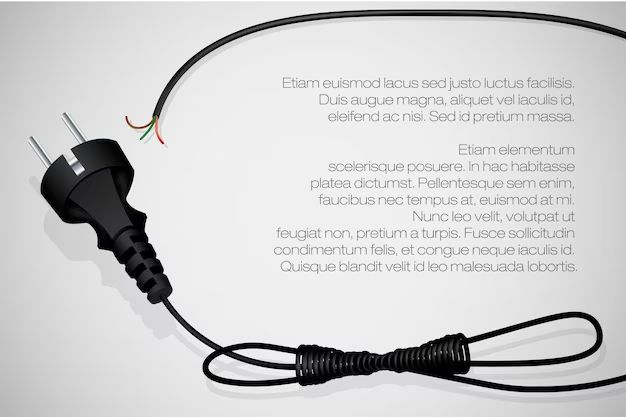An extension cord is a very useful tool that allows you to extend the reach of an electrical outlet. On each end of the extension cord is a plug that connects to an electrical device or outlet. But what exactly are these plugs called? Let’s take a closer look at extension cord plug terminology.
Page Contents
The Male Plug
One end of the extension cord features what is known as a male plug. This plug has two flat prongs and a round pin that fit into the female receptacle. The male plug connects to the female outlet or receptacle to draw power and extend it through the length of the cord.
Some key characteristics of the male plug include:
- Two flat blade prongs – Made of metal, these fit into the hot and neutral slots of the female receptacle.
- One round pin – Also made of metal, this prong fits into the grounding hole of the female receptacle.
- Plastic body – Houses and secures the prongs.
- Cord strain relief – Reduces strain on the internal wiring of the cord where it connects to the plug.
The two flat blades allow current to flow to power a connected device, while the round pin connects to ground for safety. When you plug in an extension cord, the male plug always connects to the receptacle or outlet while the female end connects to the device.
The Female Receptacle
On the other end of the extension cord you’ll find the female receptacle or outlet. This consists of slots that accept the male plug. There are openings for the flat blades and round grounding pin.
Key features of the female receptacle include:
- Hot and neutral slots – Allow the flat blades of the male plug to insert to conduct electricity.
- Grounding hole – Allows insertion of the round grounding pin.
- Holes may be shrouded – Prevents fingers from touching live parts.
- Cord strain relief – Reduces cord wiring strain where it connects.
The female receptacle may also have shutters that close when a plug is removed to prevent dust buildup and access to live parts. It securely mounts to the cord to provide a sturdy connection point for a plug.
Other Names and Terms
While male plug and female receptacle are the most common terms used, you may encounter other names for extension cord ends including:
- Male connector – Alternate term for the male plug.
- Female connector – Alternate name for the female receptacle.
- Male end – Refers to the plug end of the cord.
- Female end – Refers to the receptacle end of the cord.
The plug and receptacle ends may also be referred to based on their function or shape:
- Inlet plug – Refers to the male end that connects to the outlet.
- Outlet receptacle – Refers to the female end devices plug into.
- Two-prong/three-prong – Describes shape of male plug.
- Blank receptacle – Refers to shape of the female end.
Some other electrical terms you may encounter related to plugs and receptacles include:
- Live – Refers to a slot or terminal which is electrically live or hot.
- Neutral – The return for completing the electrical circuit path.
- Grounding – Path for electrical safety, not current flow.
- Mounting strap – Holds the receptacle in an electrical box.
While there are some variations in terminology, “male plug” and “female receptacle” are the most standard terms used for extension cord ends and their components.
Configurations and Wiring
Extension cords come in different configurations in terms of the number of prongs on each end:
| Cord Type | Male Plug | Female Receptacle |
|---|---|---|
| 2-Prong | 2 flat blades | 2 slots |
| 3-Prong | 2 flat blades, 1 round grounding pin | 2 slots, 1 grounding hole |
A 2-prong cord does not have a ground wire while a 3-prong cord will have:
- Hot – Black colored wire.
- Neutral – White colored wire.
- Ground – Bare copper or green wire.
The grounding wire connects the round grounding pin and grounding hole to safely ground the connected device. Proper wiring is essential for safe electrical conductivity and operation.
Materials
Extension cord plugs and receptacles are made from durable plastic and metal to withstand repeated use:
- Plastic housing – Usually PVC or polyethylene providing insulation.
- Brass pins – Used for its corrosion resistance and conductivity.
- Steel blades – Also corrosion resistant and highly conductive.
- Rubber – Used for flexible insulation and waterproofing.
High quality extension cords will utilize UL-rated components that are designed and tested for safety.
Safety Tips
Be sure to follow these safety tips for extension cords:
- Never overload cords with more wattage than rated for.
- Do not use damaged cords – discard and replace.
- Never plug an extension cord into another cord.
- Use caution when using outdoors – keep dry and off ground.
- Don’t run cords through walls, doors or ceilings.
- Use caution when unplugging to pull from the plug, not the cord.
Adhering to the manufacturer’s ratings and following these tips will ensure safe electrical use.
Conclusion
In summary, the key terms to know are:
- Male plug – End with prongs that connects to outlet.
- Female receptacle – End with slots that devices plug into.
- 2-prong – Plug and receptacle without ground.
- 3-prong – Plug and receptacle with ground pin and hole.
While there are other terms used, male and female ends are most common. Following safety guidelines and manufacturer ratings will ensure proper and safe use of extension cords and their plug and receptacle connections.
